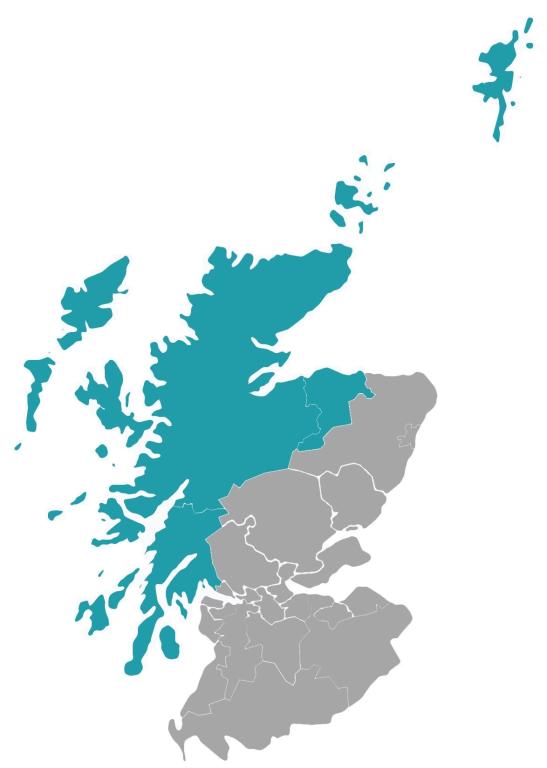Population: 448,253
Area: 38,955 km2
Unemployment Rate: 5% (February 2021), ranging from 3% in Orkney to 7% in Argyll & Bute. Pre-Covid levels were 2.3%.
HITRANS (shown in blue) is covering nearly 50% of Scotland’s land but with less than 10% of the country’s population. Most of the region is therefore classed as remote rural. The area is diverse, including remote mainland, rural areas, urban areas, like Inverness, and remote islands with population under 100 inhabitants. Transport challenges vary, with road congestion in some areas and ferry service issues in others. The small scale of the local market means that many businesses have a strong outward focus, selling goods and services outside the area. The region’s dispersed settlements pose challenges for the transport network, affecting public transport cost effectiveness, road fuel costs, and journey distances. The challenge is to continue to develop our transport network without compromising our pristine environment.

With a population of 448,253, HITRANS has an aging demographic, with 23% aged 65+, compared to 19% in Scotland. Some areas are growing, but the region as a whole is less prosperous than the Scottish average. It is generally recognised that improving the transport network will play an important part in increasing income of the population to close the gap with the rest of the country. Transport poverty is a concern, with 58% of data zones in the region at high risk, compared to Scotland’s average of 38%. Public transport limitations, lack of joined-up services, and long journey times hinder accessibility.
HITRANS has over 200,000 jobs and many areas rely on tourism for employment. The environmental resources of the area – wind, wave and tidal – presents a major economic opportunity through renewable energy. Areas within the HITRANS region have been identified as some of the worst hit for job losses in Scotland due to COVID-19, with a 119% increase in unemployment rates in HITRANS compared to Scotland’s 96%. Transport challenges hinder youth education and employment, and COVID-19 has impacted public transport use, contributing to a decline in bus services and rail passenger journeys in the HITRANS area.

HITRANS role in RURALITIES is to lead one of the SIMSES focusing on rural transport. Covering the Western Isles, Orkney, Highland, Moray, and much of Argyll and Bute, HITRANS is a regional transport partnership in Scotland. Despite its large area (50% of Scotland), it has less than 10% of the population, mainly in rural communities relying on transport for essential services. HITRANS collaborates with councils, the Scottish Government, and other stakeholders to enhance transport services, supporting economic growth and reducing barriers to participation in various activities. The region faces diverse transport challenges, from road congestion in the Inner Moray Firth area to ferry service costs in islands like Argyll & Bute. Despite being home to cities like Inverness, the area's physical features, including coastlines and mountains, pose barriers to movement, making routes slow and circuitous. With less than 10% of Scotland's population, businesses focus outward, making transport links crucial for the region's economic connectivity.

This project has received funding from the European Union’s Horizon Europe research and innovation program under grant agreement no 101060876. UK participants in Horizon Europe Project RURALITIES are supported by UKRI grant numbers: 10051963 The Highlands and Islands Transport Partnership and 10050988 Earthwatch Europe.
